A STUDY IN CONTRASTS
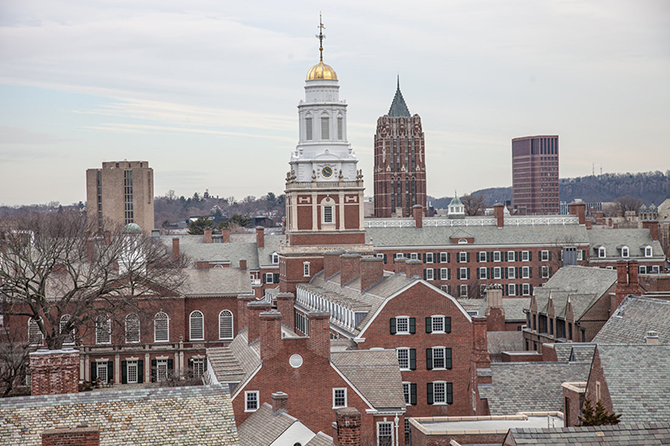
By Michael Alpiner
Many college towns exist on the concept that the college or university is the star, and the rest of the town mere players in the great scholarly drama. The college is often the center of marketing, revenue, and social culture. However, though Yale University is one of the most renowned institutions of higher learning, it exists alongside the city, not upstaging it. Its presence can be felt in the city’s artistic and historical pride, as well as in the hip, millennial character of its trendy shops and its contemporary flavors.
The 80-mile trip from New York City to New Haven should take two and a half hours on I-95. On the last leg of the journey, motorists are treated to a view of New Haven Harbor, an arm of the Long Island Sound, with boats docked by the shore, and, if the weather is right, vessels coasting with the wind in their sails. Once in town, one will notice many streets named after the people who found renown in this New England city. Names like Whitney (Eli Whitney), Sherman (Roger Sherman), and Goodyear (Charles Goodyear). This is not unusual; nearly every town and city in the world recognizes their distinguished past in this way. Yet, there is something about the particular embrace that New Haven delivers to its past that inspires in its visitors the same open-arm feeling.
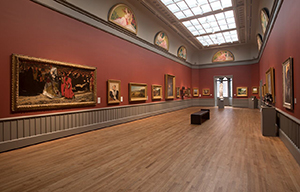 View of the American painting and sculpture galleries, Yale University Art Gallery
View of the American painting and sculpture galleries, Yale University Art Gallery ©Jessica Smolinski
IVY LEAGUE STYLE
The architecture of New Haven is the apparent visual theme for any visit to this second largest city in Connecticut. New Haven is rich with Victorian, Georgian revival, and high gothic architectural styles. In fact, most of the buildings that comprise Yale University are reminiscent of the original structures, keeping to the styles, and even containing sections and artifacts from the originals. One impressive building is Phelps Hall, which was created to resemble an English gatehouse, and opens up the campus through Phelps Gate, an access way from College Street into the quadrangle of the Old Campus area.
It’s a two-block walk to another unique building, Beinecke Rare Book and Manuscript Library. A bibliophile paradise, this Vermont marble, and granite structure features exterior panels of marble just thick enough to allow light to enter, defused enough to illuminate the interior while protecting the rare editions from harmful UV light. Within the geometric walls lives The Gutenberg Bible, the first Western book printed from movable type, original Audubon bird prints, and about a million other rare finds.
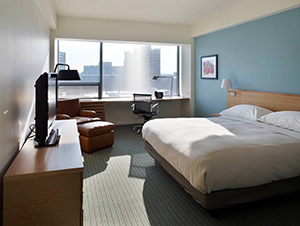 The Study at Yale Hotel
The Study at Yale HotelA MAJOR IN COMFORT
The scholarly theme continues if one stays at The Study at Yale, which defines itself as a “cultural platform” that fits into the university aura, yet succeeds as a new boutique hotel. The lobby is divided by a wall of books (donated by The Strand in NYC), of which one might be enjoyed in a variety of comfy leather chairs with a cup of gourmet coffee. The staff is courteous and helpful, the decor engaging with art and photographs, and the rooms scholarly and serene. Imagine a dorm room on steroids, large comfortable bed, powerful shower, plush furnishings, and a wall-length writing desk that looks out over the landscape of New Haven. Natural light pours in through the large bay windows while creativity pours out onto the erudite page.
The hotel features a top-shelf bar with a wide array of international wines, and a gourmet restaurant called the Heirloom whose menu is rich with New England favorites such as oysters, shrimp, scallops as well as lamb, duck, and steak. Much of the food comes from local growers and artisan purveyors of New England cuisine. Executive Chef Carey Savona, a product of New Haven, worked alongside some of the most celebrated chefs in the country to form the foundation of his distinct culinary style.
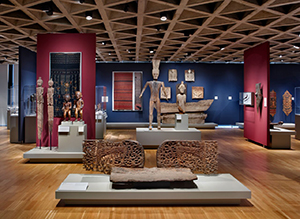 View of Indo-Pacific art galleries, Yale University Art Gallery © Elizabeth Felicella
View of Indo-Pacific art galleries, Yale University Art Gallery © Elizabeth FelicellaA CLAIM TO FAME
Not all specialty food in New Haven is haute cuisine, but many eateries are both historical and delicious. New Haven residents are proud to claim several “firsts.” The Frisbee originated in New Haven as did the lollipop, the concept of a planned city grid, sulfur matches, spring tape measure and even football. But the most pride rests in New Haven’s claim to be the home to the first hamburger and the first pizzeria. Louis’ Lunch, established in 1895, is housed in a tiny building (so no super-sizing your meal, please) and offers burgers on toast with cheese, onions, and tomatoes as the only garnishes.
A short walk away is Frank Pepe Pizzeria, which began serving “tomato pies” in 1925. Cooked in a coal-fired brick oven, the result was a crispy and authentic pizza. The recipe for pizza perfection is still used today. The pride that comes from this family-owned and operated business continues today as Frank Pepe’s grandchildren are still integral members of the business. Pepe’s has been visited by many notables, such as Frank Sinatra, Bill and Hillary Clinton, and John Kerry, just to name a few.
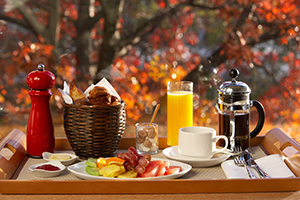
CULTURAL PURSUITS
The New Haven experience would not be complete without a visit to the Yale University Art Gallery and the Yale Center for British Art. One across the street from the other, these museums span the career of famed architect, Louis I. Kahn, who designed the structures, the Yale University Art Gallery at the start of his career, and the Yale Center for British Art around the time of his death. Both house impressive collections of world art, from sculpture to installation, to oil on canvas. The artists’ work is curated with knowledge and care, and the floor plans accessible for viewing pleasure. The internal structures of the museums, especially the spiral staircases, make the actual building part of the overall artistic experience.
Nearly every experience in New Haven is touched with the sense of pride in the past and understanding of the contemporary. An undergrad in a Yale sweatshirt gazing up at the bronze statue of Nathan Hale is as familiar as groups of tourists and locals scarfing down both trendy and traditional fare. New Haven is a city where the rough beauty of the past meets the youthful face of the future with mutual respect.
Michael Alpiner’s writing and publishing includes travel/hospitality articles as well as fiction and poetry. His poetry is included in the anthology, Blood to Remember. Michael earned an MFA in Creative Writing, teaches college writing, and has served as a Writer-in-Residence for the Louis Armstrong Museum. He is co-founder of ExtremeLuxuryGetaways.com.







